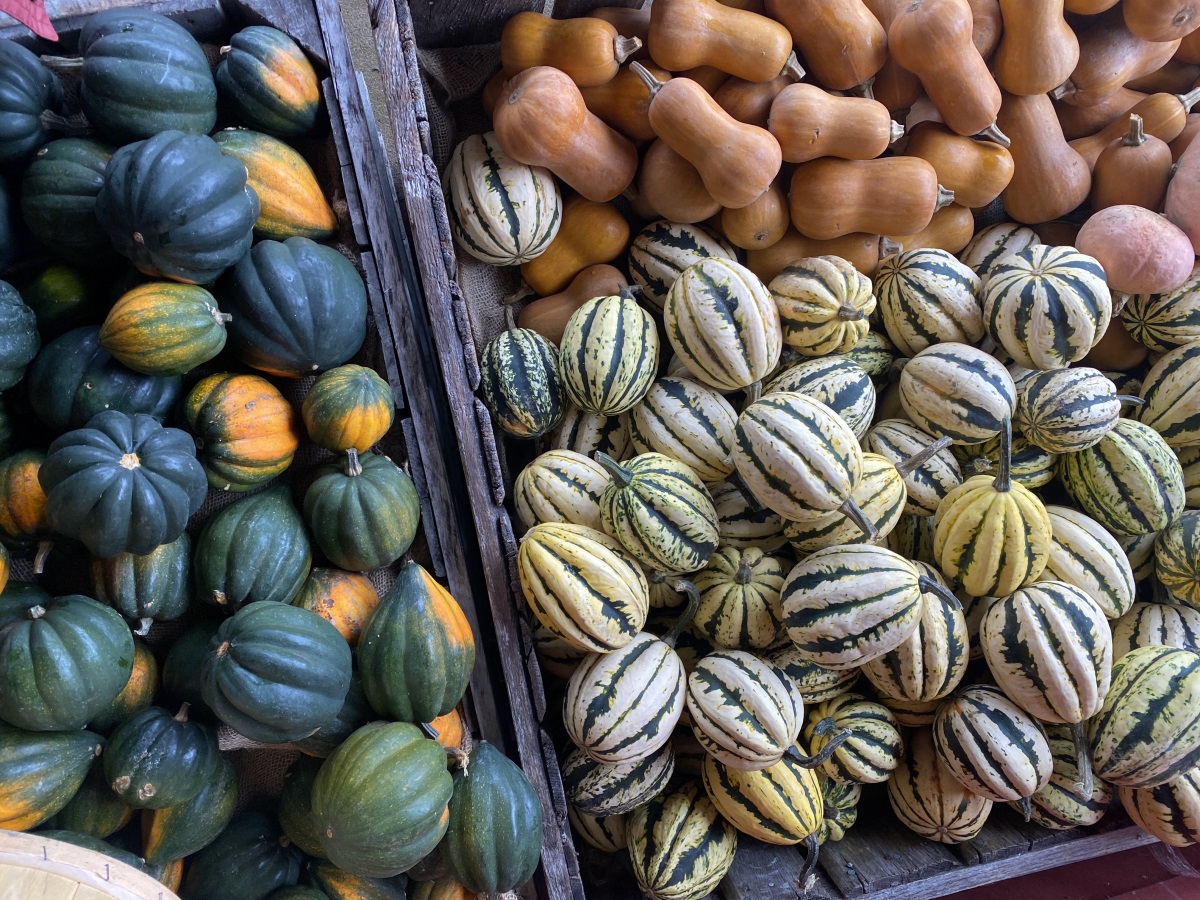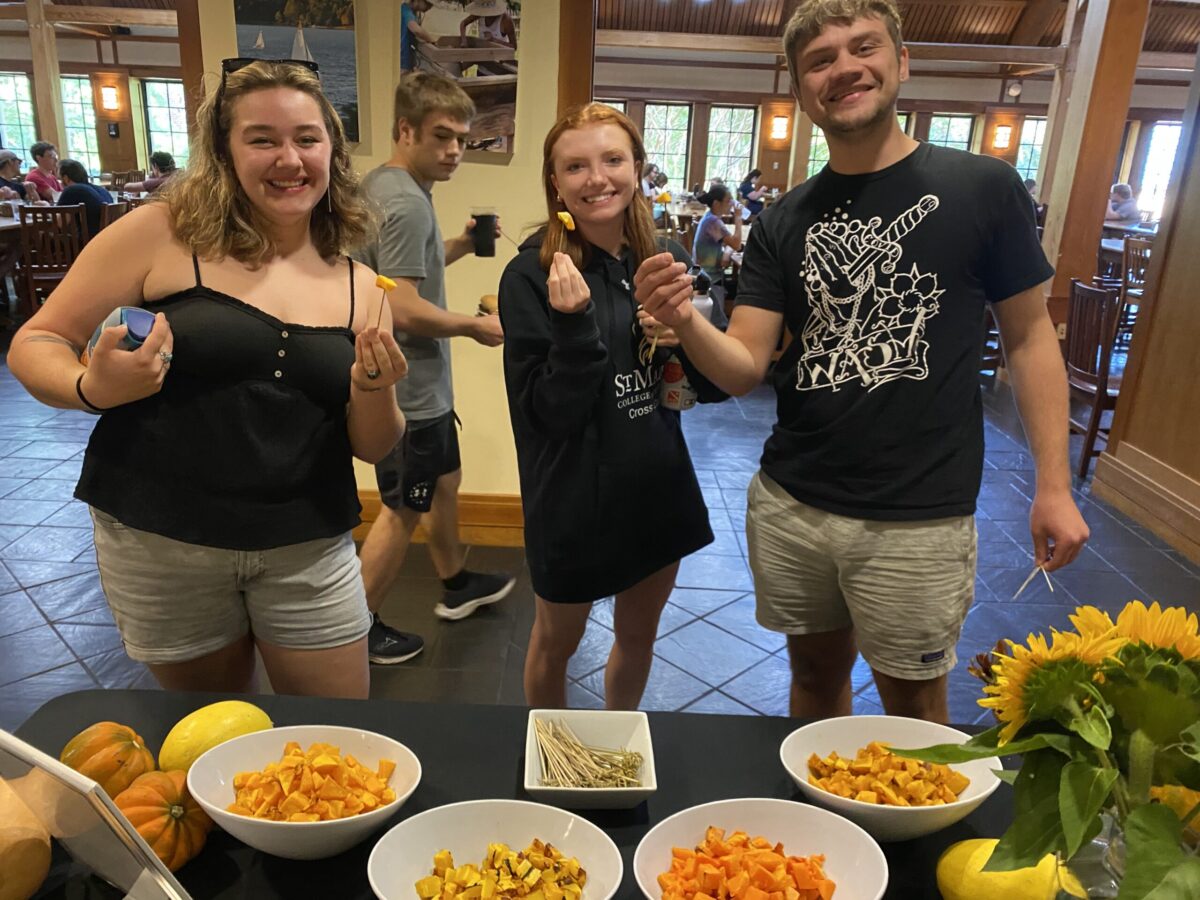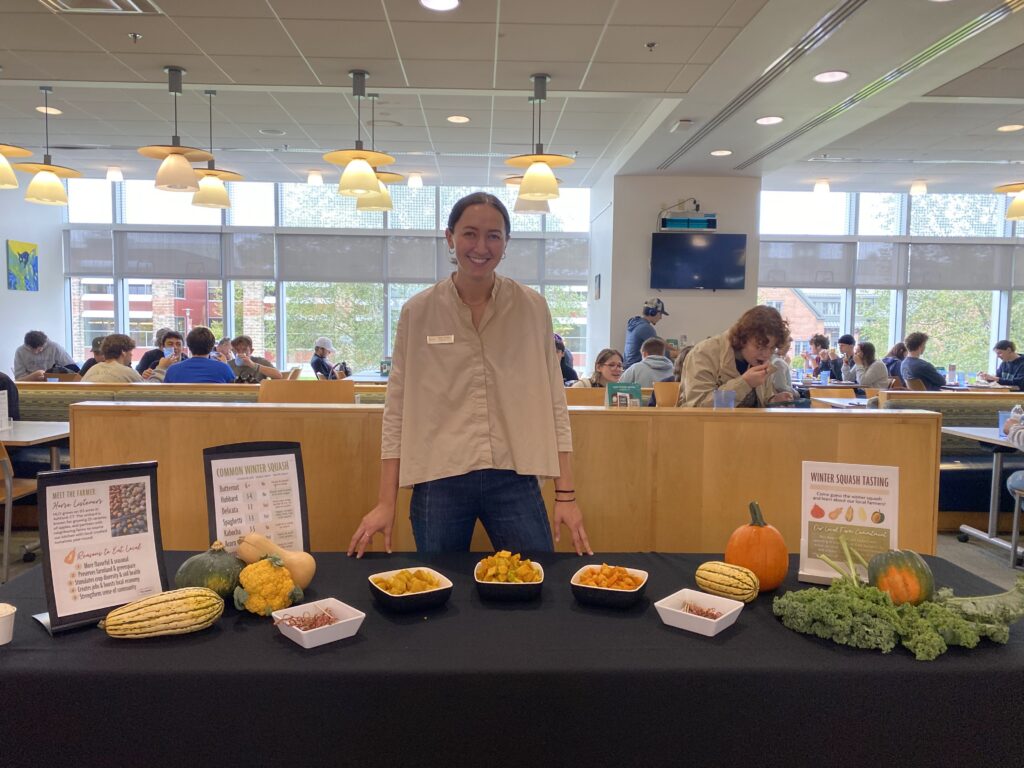From Koginut to Kabocha: Tasting the Rich Diversity of Winter Squash
- by Elise Dudley

As winter’s chill settles in, cooks often turn to storage crops, including a vibrant array of hardy winter squash, each with its own special flavor profile and gastronomic potential. From the robust and well-known butternut to the delicately sweet acorn, ornamental turban squash, and velvety texture and nutty flavor of Koginut, these nutrient-rich and flavor-packed vegetables define the essence of the season. Distinct from their tender summer counterparts, winter squash boasts dense flesh, rich textures, and an earthy sweetness that intensifies during storage, making them a go-to ingredient throughout winter, especially in colder-climate regions.
In Bon Appétit Management Company cafés across the East Coast from South Carolina to Maryland, Ohio, and New York, I’ve been celebrating these seasonal treats and inviting guests to learn more about the diversity of the squash crop. As a Fellow, I’ve collaborated with our culinary teams at colleges and universities to procure winter squash varieties from a local farm or campus garden, and then a chef prepares the squash for students to taste during lunch in their café.
Spoiler Alert: Students Discover that Squash is Delicious
At St. Mary’s College of Maryland, students tasted samples of roasted butternut, kabocha, Hubbard, and delicata side by side. Many students were pleasantly surprised by the flavor and texture of the squash, explaining “I never liked squash as a kid,” or exclaiming that “I might have been converted to actually liking squash!” The candy-like sweetness of the Hubbard and the delicata’s crisp skin and flavor reminiscent of sweet potato stood out as favorites.

Students at St. Mary’s College of Maryland expand their taste horizons.
In Ohio at Denison University, students tasted spaghetti, butternut, and kabocha, many amazed by the unique pasta-like texture of the spaghetti squash. A couple of students remarked, “Wow, this is surprisingly delicious,” and “I never knew squash could have so many textures.” In Rhode Island, students at Roger Williams University also had the pleasure of tasting and attempting to identify acorn, Hubbard, and delicata. As guests stopped by to participate many also shared family recipes such as stuffed acorn squash, butternut squash pie, and a Portuguese squash porridge (yum).
A Core Element in Cuisines Across the Globe
In cultures worldwide, winter squash has a starring role in many traditional dishes, central in everything from earthy stews to intensely sweet pies. In Italy, squash was once considered a food for the poor, until higher classes caught on to its versatility and flavor. Long-beloved Italian squash dishes include a pasta filled with butternut squash common in the Emilia-Romagna region, and a sweet pumpkin-filled ravioli from Lombardy.
In present-day Mexico and Central America, Indigenous people were some of the first people to recognize the value of squash as a food source. In Guatemalan cuisine, it’s prominent in many traditional dishes such as ayote en miel, braised winter squash in a thick spiced syrup. In Japan, the kabocha squash has been an enduring winter staple, often prepared as a savory soup or simmered with adzuki beans for good luck. And in the U.S., winter squash is savored in sweet pumpkin pies during the holiday season.
Why Heirlooms Matter
Why should we care about these squash varieties? Consuming a diverse assortment of vegetables is a boon for good health, of course. And if we build demand for a broader range of cultivars, we can also maintain biodiversity and keep heirloom varieties alive.
Heirloom crops are storied cultivars of a plant grown and used as food. Once we’ve lost an heirloom variety or wild crop, it’s gone forever. Many of these varieties have been cultivated since before the advent of industrial-scale agriculture, having adapted to their native region over many years. While they typically resist the kind of standardization needed in industrial agriculture, heirlooms’ presence on smaller farms and in local markets adds to crop diversity. Beyond benefits to human health, cultivating a diversity of crops supports healthy ecosystems, soil fertility, and increases the likelihood of having varieties that are resilient to threats of pests, diseases, and changing climatic conditions.
According to the FAO’s 2019 report on the state of biodiversity in food and agriculture, there are over 6,000 plant species that have been historically cultivated for food, while fewer than 200 presently contribute in a significant way to global food production. Moreover, just 9 crops account for 66% of total crop production—a striking absence of diversity.
Protecting Agricultural Diversity in the Face of Change
As increasingly extreme weather events, shifting agricultural practices, and other social and technological forces transform our global foodscape, there is increased pressure on plant breeders and scientists to develop more resilient and productive varieties, while continuing to honor the cultural heritage of our agricultural systems. Protecting genetic diversity is even recognized within the United Nation’s Sustainable Development Goals to create a world free of hunger. This effort to ensure sustainable food production systems must balance the need for more resilient crops with recognizing the value of heirloom varieties. Threats to crop diversity undermine the resiliency of our food system at large, it is as simple as that.
Solving the challenge of sustainably feeding a growing global population (while managing the impacts of climate change on agriculture) hinges on a commitment to conservation and crop diversity. As both consumers and culinary professionals, we must continue to eat a variety of crops and stay open minded to unfamiliar varieties. Which brings us back to winter squash.

Fellow Elise Dudley brings her squash knowledge to students at Roger Williams Univerity.
If you’re new to preparing winter squash, we have a few tips for you. Winter squash’s tough, thick rinds allow for long storage in the winter months, but getting through the tough skin can be daunting. Our chefs have some ideas for doing so safely!
- Many winter squash possess edible and nutritious skin that doesn’t need to be removed. One of our favorite thin-skinned varieties is delicata—slice in half lengthwise, scoop out the seeds, slice into strips (or keep it halved) and roast.
- First, it’s important that you wash your squash with warm water and soap before you place it on the cutting board for prep. Next, shave or slice off a thin sliver on one side to create a flat surface. Flip the squash onto the flat surface and start cutting as you need. – Executive Chef Anthony Legname at Vassar College
- A vegetable peeler can be a helpful tool for removing the skin from varieties like butternut, Koginut, and Hubbard. Alternatively, you can puncture the skin with a knife or fork and soften the rind by microwaving on high for 4-6 minutes or placing in oven at 375°F for around 15 minutes to soften before cutting.